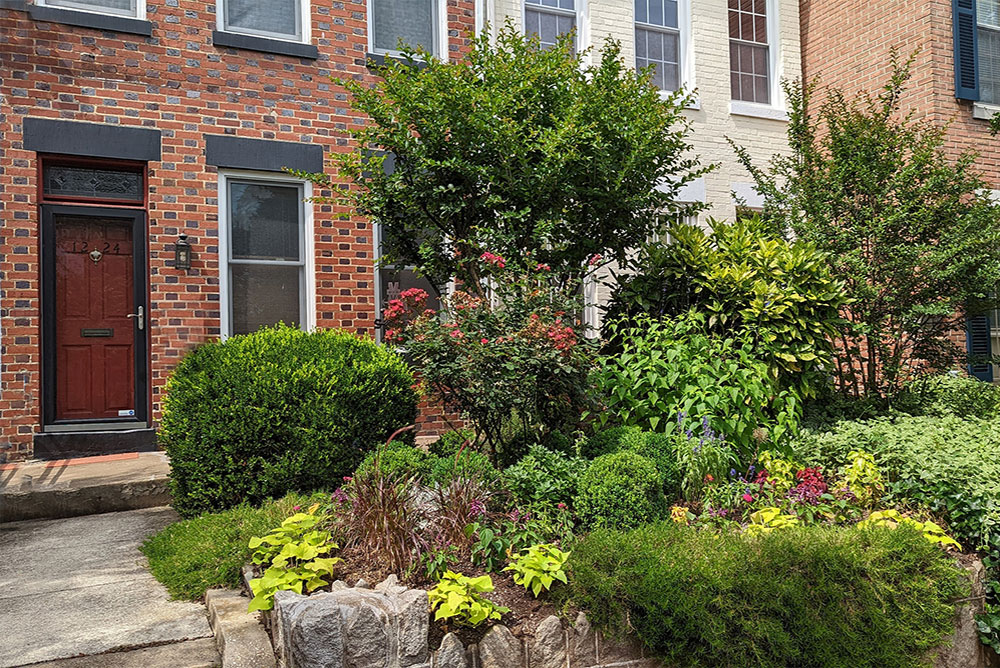
A neighbor’s garden, where everything was planned and looks good all the time. Clearly the homeowners have more discipline than I, writes LittleBird Stephanie. / Photo by Stephanie Cavanaugh.
By Stephanie Cavanaugh
THERE’S A pea patch of a garden a block from here, maybe eight feet square. In the upper right corner is a crape myrtle, tall enough to tickle the second-story window of the red brick row house. Stepping down are three large shrubs and a bushy tea rose encircled with boxwood. Creeping phlox drapes along the front wall. Three sweet-potato vines are beginning a satisfying tumble over the front corner. A river of seasonal flowers and foliage meanders between: a froth of native grass, blue lobelia, deep red coleus. In fall these will be replaced by pansies and cabbages that will be a lively sight through the winter.
It’s such a perfectly structured garden that even a fool of a gardener could keep it effortlessly lovely for decades. And it always—always—looks good.
Last week I wrote about a visit to Dumbarton Oaks, the superb garden in upper Georgetown that is magnificent even when pausing between acts, which it is now. Spring having past along with the glory of tulips and lilacs, roses, wisteria, and cherry trees. Summer not quite awake, the new season just emerging.
Said Bird managing editor Nancy McKeon, “I’m surprised you didn’t make the explicit point that these between-times are why gardens need structure. That’s why the place looks so good all the time. I know you talk about the details, but I don’t think people are necessarily going to understand that there’s a larger concept.”
Her comment caught me up because I both never think about structure and, at the same time, always think about structure. Structure is quite beyond me.
I admire gardeners who announce: I’m going to re-create Monet’s Giverny, and do so, carefully studying the space, existing colors of surrounding buildings and trees, adding textures and plants and flowers with four seasons of interest.* On a simpler level, I admire gardeners who observe the rule of three, and plant lovely groupings that grow thick and impressive.
These are the sorts of gardeners who have patience. They read the labels and follow the instructions to plant 6 or 8 or 12 inches apart and are happy to watch plants fill in gradually, year after year. They also believe it when told those pretty things require full sun, which does not mean full sun for 15 minutes at 8am, followed by increasing dapple.
Those people are not me.
That garden a few blocks away began with a few carefully selected plants, which probably looked like nothing for several years (I base this on not noticing them). It took years to establish, but now the rewards are being reaped for the garden’s owner and passersby. What a smart thing to do, one mutters to oneself.
As I’ve written (too many times) we were never going to stay in this house; a good starter, said we. We were already stuck with an apricot tree, a sprig of a thing the previous owner planted among the laundry lines. I added a couple of grand ideas—wisteria and honeysuckle to cover the fence walls (who cares if they’re invasive, we won’t be here. Right?). Someone was throwing out roses, so we stuck those in. Dinner guests arrived with hydrangeas, so we stuck those in too. I found a pond in a thrift store. Pond! Annuals filled any gaps. Somehow 38 summers have moved on, but not us.
The invasives did what they do, crept along laughing and throttling whatever was in their path. Facing off with each other, the horticultural equivalent of King Kong vs. Godzilla. The roses, for whatever long-forgotten reason, were planted on the garden’s dark wall. They died. And so forth.
With a garden so small and with so many wants, no rule of three for me. One this, one that, stuck in whatever space. Last week my magpie eye squeezed in a single pinkish red caladium, a small pot of ballet slipper pink fuchsia, and a bit of lavender. I just wanted them, dammit.
Sometimes I think of ripping it all out and starting over. But now life itself has grown too short. I doubt I’d be around to see it all mature; Baby will have trucked me off to a rest home—or I’ll be mulching heaven.
Just to be a Debbie Downer.
*Re-create Giverny? Here’s a start. Read it and weep, as I did.

I’m right with you on this. I look at beautiful gardens and want one. But I kill cactus. I really can’t keep much alive, although for some reason I’ve had a peace lily that’s still around after several years. But peace lilies are very forgiving. If we could afford a gardener, that would be grand. But not happening. Loved the visual on the invasives!
Stephanie
From one greedy gardener to another…sometimes structure is trumped by whimsical disorganization! If it makes you smile to cram it all in, I say let the critics be damned. It’s your garden.
Btw, the visual of the invasives laughing and throttling everything in their path…and King Kong meeting Godzilla…made me lol. Thank you!